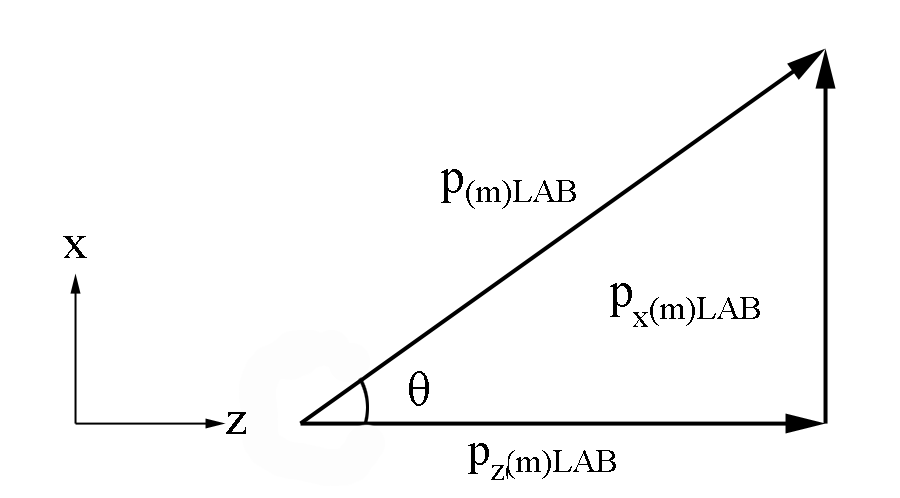Difference between revisions of "DV Calculations of 4-momentum components"
| Line 76: | Line 76: | ||
| − | <center><math>\left( \begin{matrix} | + | <center><math>\left( \begin{matrix}E^*_{1}+E^*_{2}\\ 0 \\ 0 \\ 0\end{matrix} \right)=\left(γCM00−βCMγCM01000010−βCMγCM00γCM \right) . \left( E1Lab+E2Lab00p1zLab+p2zLab \right)</math></center> |
Revision as of 02:49, 31 December 2015
Calculations of 4-momentum components
Initial Lab Frame
Assume the incoming electron has momentum of 11000 MeV in the positive z direction.
The moller electron is initially at rest
The total energy in this frame
Center of Mass Frame
Using the definition
We can use 4-momenta vectors, i.e.
we can use the fact that the scalar product of a 4-momenta with itself,
is invariant
Using this, the sum of two 4-momenta forms a 4-vector as well
The length of this four-vector is an invariant as well
For incoming electrons moving only in the z-direction, we can write
We can perform a Lorentz transformation to the Center of Mass frame, with zero total momentum
Without knowing the values for gamma or beta, we can use the fact that lengths of the two 4-momenta are invariant
Setting these equal to each other, we can use this for the collision of two particles of mass m1 and m2. Since the total momentum is zero in the Center of Mass frame, we can express total energy in the center of mass frame as
Using the relations
In the frame where one particle (m2 Lab) is at rest
which implies,
where
Inspecting the Lorentz transformation to the Center of Mass frame:
For the case of a stationary electron, this simplifies to:
which gives,
Solving for , with
Similarly, solving for by substituting in
Using the fact that
This gives the momenta of the particles in the center of mass to have equal magnitude, but opposite directions
Using the relation
Moller electron Lab Frame
Finding the correct kinematic values starting from knowing the momentum of the Moller electron, , in the Lab frame,

Checking on the sign resulting from the cosine function, we are limited to:
Since,

Checking on the sign from the cosine results for
Moller electron Center of Mass Frame
Relativistically, the x and y components remain the same in the conversion from the Lab frame to the Center of Mass frame, since the direction of motion is only in the z direction.
Electron Center of Mass Frame
Relativistically, the x, y, and z components have the same magnitude, but opposite direction, in the conversion from the Moller electron's Center of Mass frame to the electron's Center of Mass frame.
where previously it was shown
Electron Lab Frame
We can perform a Lorentz transformation from the Center of Mass frame, with zero total momentum, to the Lab frame.
Without knowing the values for gamma or beta, we can use the fact that lengths of the two 4-momenta are invariant
Setting these equal to each other, we can use this for the collision of two particles of mass m1 and m2. Since the total momentum is zero in the Center of Mass frame, we can express total energy in the center of mass frame as
Since momentum is conserved, the initial momentum from the incident electron and stationary electron is still the same in the Lab frame, therefore
This is the same as the initial total energy in the Lab frame, which should be expected since scattering is considered to be an elastic collision.
Since,
Using the relation
Using
DV_RunGroupC_Moller#Momentum distributions in the Center of Mass Frame